A terrible way to end friendships.
Type: Co-op, Single-player
Genre: Puzzle
Developer: Solis Studios
Publisher: Solis Studios
Release date: 31 July, 2020
Intro
EDIT: As of September 3rd, HEX Hacking Simulator was given a significant update which adds a much more meaningful tutorial and the ability to read the instructions for each node before being put on the clock based upon criticisms and feedback like the one in this review. This game wasn’t given a “score” as an Early Access title, but it would be worth bumping the evaluation up a rank for this factor alone, as the lack of tutorial was a major factor in the raw frustration of getting into this game, and it is a very welcome improvement.
Fundamentally, HEX is a co-op game in the vein of Keep Talking and Nobody Explodes that for some inexplicable reason is given a single-player mode and where SoQ was given a single key. I honestly get the sense that the developer made it single-player just to test it, and decided not to take it out, rather than ever setting out to make a game to be played single-player, because you can have none of the fun doing so. Unlike a game where you’re moving two characters around ala Brothers or Biped where controlling two characters at once is at least more difficult than controlling one even if coordinating with a co-op partner is more difficult, the whole point of the co-op in this game is that one player is given information, and the other player has to act upon it. This means that the only downside to playing single-player is that you have to punch tab a bunch to swap views and you have nobody to ask “why the hell is the game built this way?” constantly while playing it.
The Name
This game was given to me as //HEX. It’s logo is //HEX in my Steam library, but the store page was changed to say “HEX Hacking Simulator” because the “//” part makes the game impossible to search for on certain search engines, and just “Hex” is already the name of a game on Steam. (As is “The Hex” and several other “hex”-related names.) The name was suddenly changed just after being launched because it was only when users were complaining about this, so enjoy the confusion.
On Hacking Games
Hacking games exist in a weird space. Most games are simulating something either very abstract that could only exist in a game (like disappearing blocks in puzzle games), or else are making simulations of the real world that are drastically incomplete because of hardware limitations and the need to build a game around the limited ways that the player can interact with the simulated world. Hacking, however, is something that already exists entirely within the world of computer programs. You could make a 100% realistic hacking simulator that consists of copies of real firewalls or computer networks because these things all exist purely on computers to start with. The only problems would be that actual hacking is either boring, difficult work, just using scripts someone else made, using phishing emails, or just calling up tech support, telling them you’re the CEO of Sony, and you forgot your password. Plus, your game would probably get a lot of negative attention if you were basically setting up an actual hacker training tool.
Much like Guitar Hero, however, people don’t want to actually learn the chords or form a real band, they just want to share in the glamor and myth of the Hollywood Hacker, who uses VR headsets to commit future crimes against oppressive governments while flying through cyberspace on a keyboard like those totally radical images in the 90s!
HEX therefore is about performing mini-games that ludicrously abstracts things while just taking other games’ ideas of what hacking is like, such as using pipes like BioShock. You also have icons that portray your character as a skellington in a parka with a laptop, because we all know hackers are notoriously averse to eating and have a skeletal countenance.
The… Plot?
HEX follows… uh… you (no really, this game, in the console tradition, has no character creation and just uses your Steam name and avatar) joining… uh… hacker club(?) one day, and being given a mission by… uh… some angry-sounding guy who apparently gave you H.A.N.N.A.H., an “AI Helper” that is neither an AI nor a helper. Angry Guy wants you to hack banks and steal their money for yourself because… I don’t know?
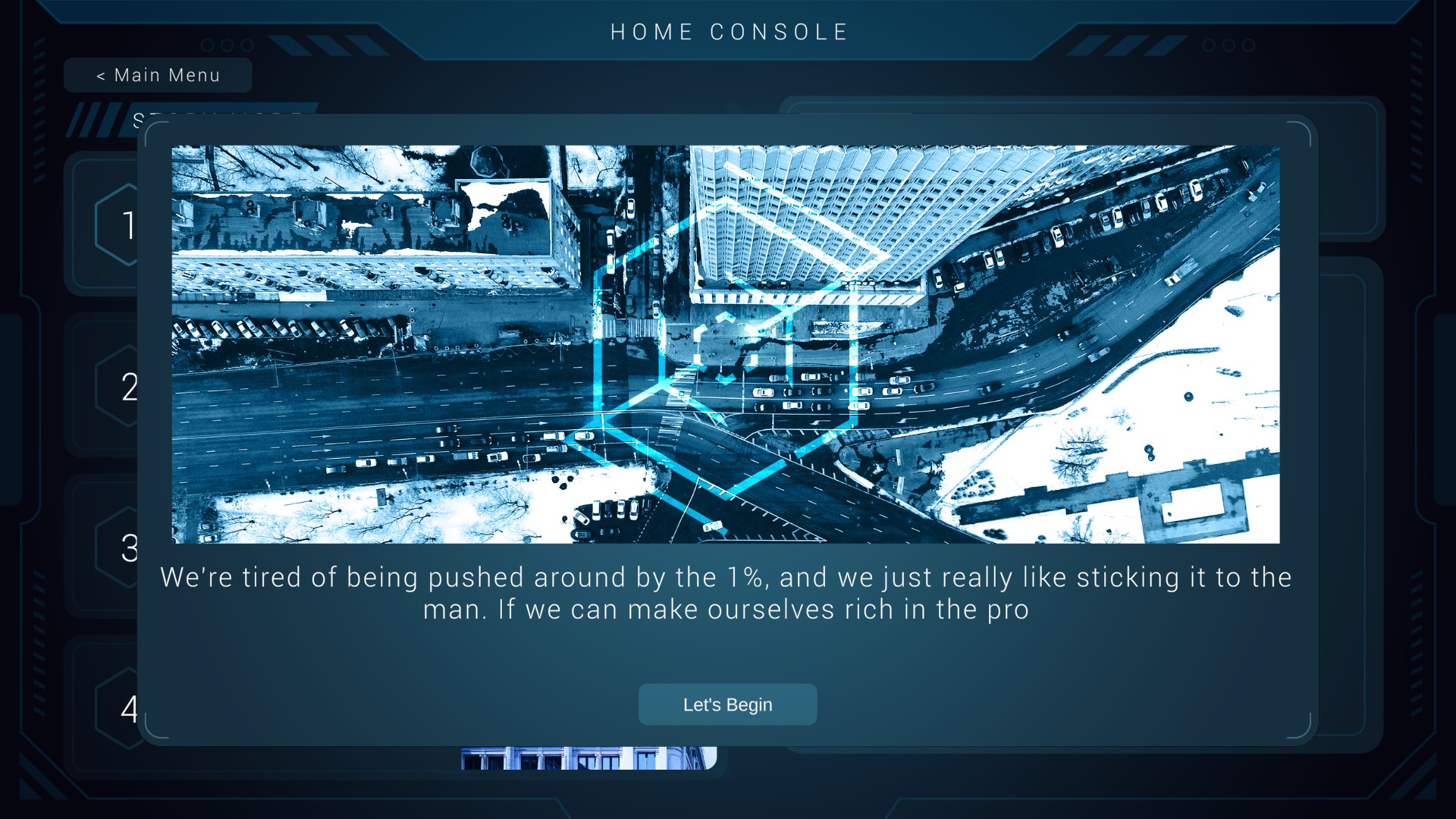
Angry Guy makes it sound like he’s doing it to get wealthy and he hates the banks, but doing so would logically require that you actually be employed by Angry Guy and/or at least be giving him a portion of the money you take. He makes it seem more like some after-school club activity where they have a quota of robbing at least 12 banks per month to rob or else the teachers will suspend the club for lack of activity, however. It makes very little sense why someone who is performing criminal activities would be giving away AIs that are evidence of their crimes to random people they apparently don’t know. If I had the ability to name my character, I’d definitely have gone as “Mr. NARC” just for the absurdity of it. There has to be some sort of test someone went through to join up, and that probably would have made for a more interesting and detailed tutorial than this game actually has.
Honestly, I get the impression that a well-conceived story of what would have actually led Rando McPlayercharacter to joining hacker club would probably have been a much more interesting story than the game itself…
The Tutorial
It barely exists.
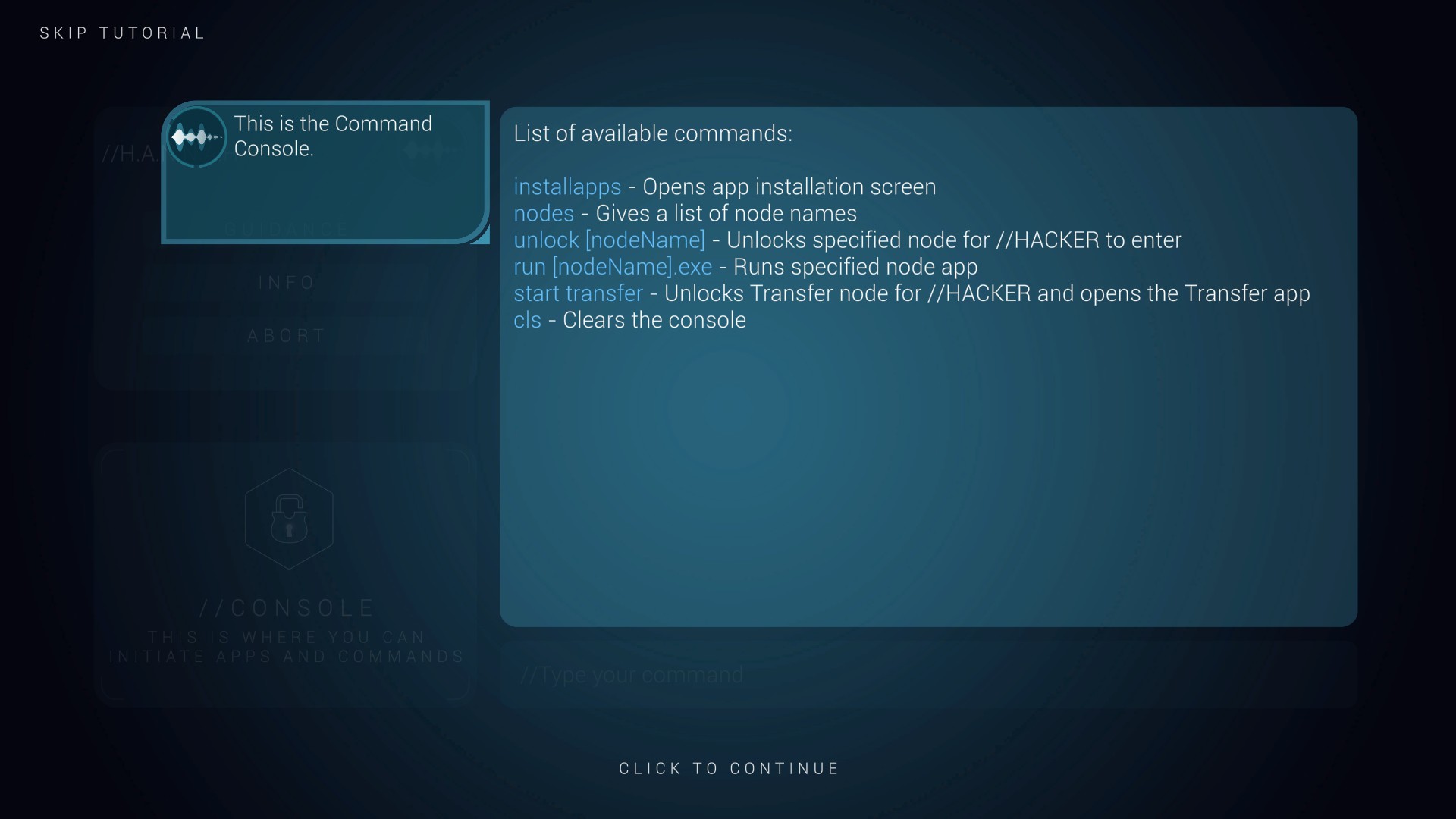
The instructions this game gives on how to play it, combined with the amazingly counter-intuitive interface could be used to teach a class on how not to design a game. The “tutorial” basically only exists to tell you how to ask for further help in-game. You know, mid-game in a game that has a 4-minute time limit and forces restarts if you make a mistake. Basically, to even read what the rules are and what you should be trying to do, you have to go into a mission and waste your time reading before having to abort and restart to reset the timer before even having a clue what you’re supposed to be doing. I can’t imagine a reason why they would prevent players from using the tutorial to have at least some idea of what the game entails other than spite for the player.
I suppose, if anything, this does give the game the aesthetic of 90’s-era Linux, where the only help you’ll get is “RTFM” and the manual is either horribly out of date or completely blank…
Visuals and Sound
It’s blue. Hacking is apparently all blue all the time in this conceptualization of hacking. As I will discuss further later, there’s a serious problem with highlighting what are the important aspects of the interface, because important buttons look like background while unimportant background looks like buttons thanks to a lack of proper use of contrast, even in such a minimalist aesthetic.
In terms of sound, it’s the bare minimum. Things make “computery” sounds like boops and tones, unless it’s one of the absurd metaphors, like wire transfers involving attaching pipes with a loud “shunk” sound and involving valves that make rusty squeaking noises. There is a voice for the AI in the ludicrously short tutorial, but other than that, the only voiced parts are the mission briefings that feature Angry Guy, whom I suspect is the developer, himself.
Interface
There are no rebindable keys, although since a lot of typing takes place, that’s a little more understandable in this game’s case. A problem I do have, however, is that the escape key only tries to abort the mission. (Note: when this pops up, the timer still doesn’t stop. If you have to answer the phone or something, you basically have to fail the mission.) This is in spite of the fact that you need to back out of several menus, and the only way to do so is by moving your hand away from the keyboard, putting it on the mouse, clicking the dark blue “x” button semi-hidden in the dark blue background, and then going back to the keyboard because all other controls are keyboard-based, especially for the Control player. When the game is timed, there absolutely should be keyboard controls for these things.
This also applies to screens where you enter by punching in keyboard commands, and then go to a command line prompt. You still have to click on the command line prompt again just to keep typing, making you needlessly take your hand off the homekeys in a game that’s basically all about speed-typing. It runs completely cross-grain to have so many mouse commands when a normal interface would just let you tap Tab… but then, Tab is the role switching button…
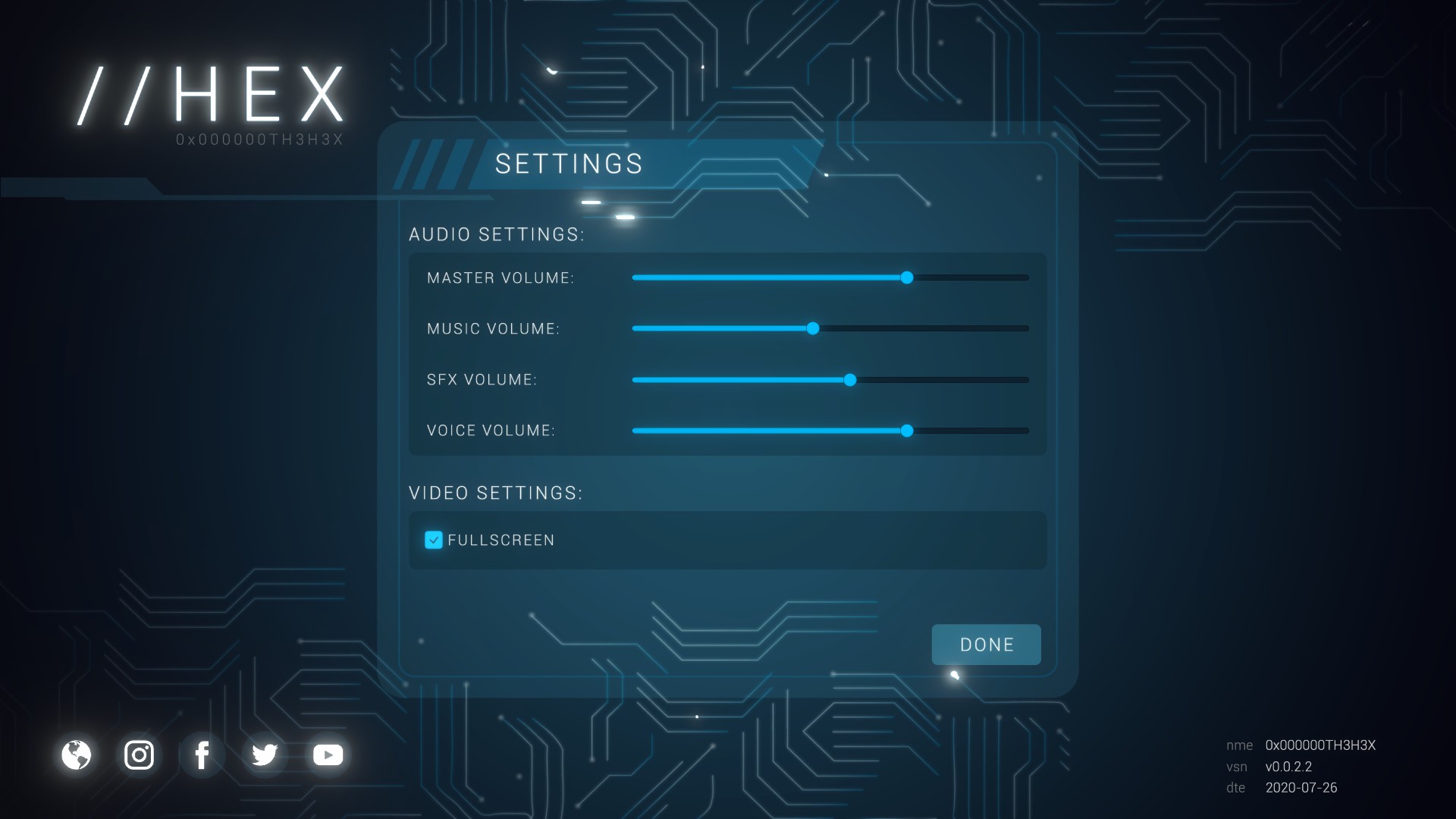
A major issue with the mouse controls, however, is that most of the intractable objects are generally not obvious. There were many times I had to spend a mission just looking for what things I was actually able to click on to interact with them, because the game has a horrible lack of grasp on what intuitive interfaces look like. Everything is in monochrome, and things that have high contrast and look like a button are not, while tiny, low-contrast objects turn out to be vital.
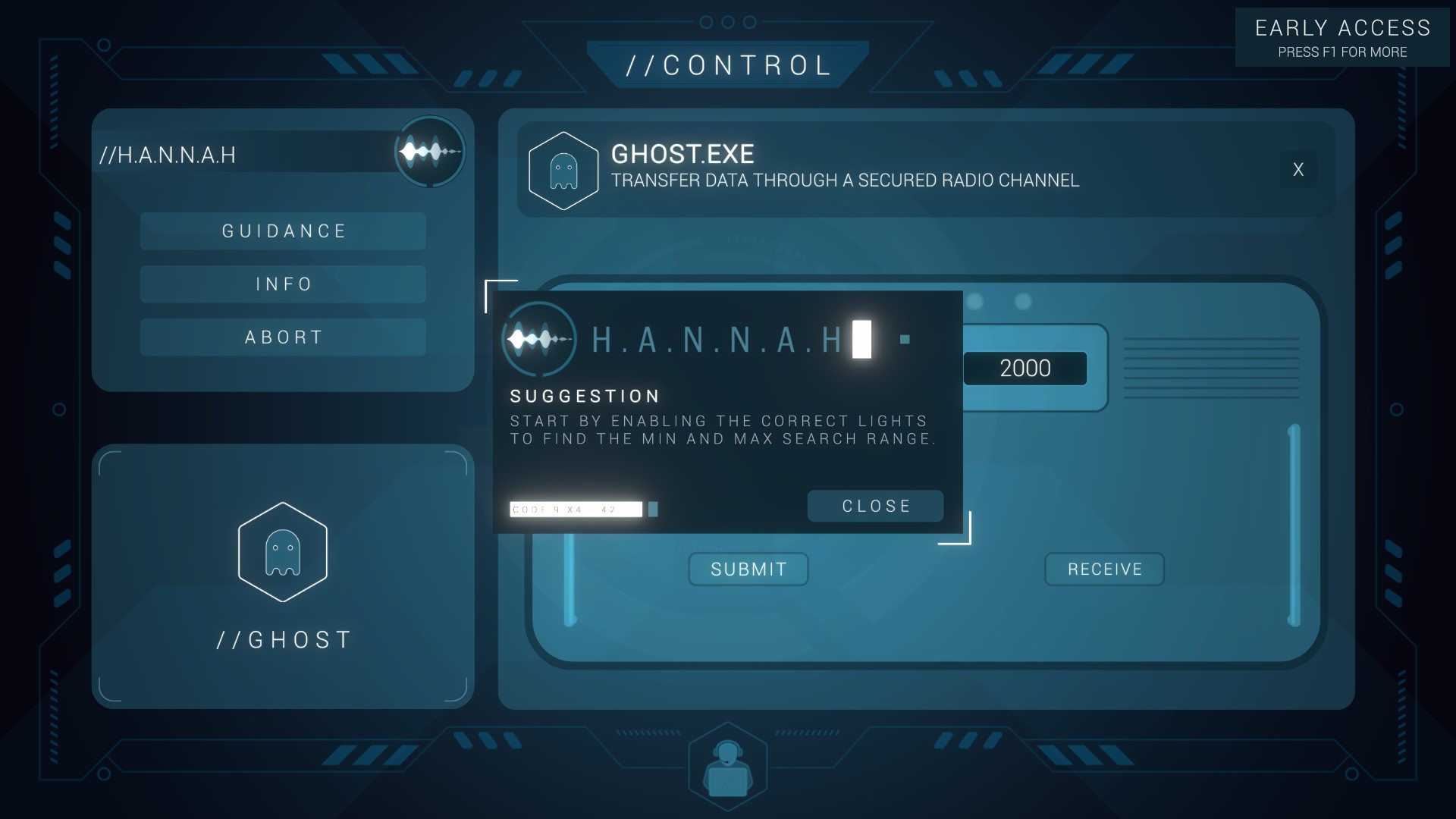
For example, the circle with the soundwave that represents HANNAH the tutorial thing does nothing on the Control side, you click the buttons underneath that say “Guidance” for what little help it will give you. On the Hacker side, there are no buttons you have to click the circle with the soundwave to get advice, even though that’s not how it worked when I was playing the other role. This played a major role in my not realizing that’s how you’re supposed to get half the (still horribly incomplete) instructions for this game, and not having the basic rules explained played a major part in the frustration this game generates especially early on because of its failure of a tutorial.
Hacker and Controller
There are two roles for players, showing how the game was blatantly built solely for co-op.
The Hacker has a much more minimalist and icon-driven interface where they go to a minigame when the Controller unlocks it for them, and does whatever nonsense the game demands of them there. Hacker roles tend to be the one that actually punches things in, while the Controller role is the one that can see what needs to be punched in, but roles can be reversed.
The Controller, meanwhile, is the one that actually feels more like a hacker (and is a hacker, wondering why you’d split hackers into two groups and only call one “The Hacker”…) and has to work far more with a text prompt. Since this is a game that is timed and you mostly use DOS/*N*X-style text prompts as a Controller, you’d definitely want to give this role to the faster typist of any pair, although again, I wonder why you’d want to ruin a friendship by playing a game as frustrating as this one as a pair, anyway.
By and large, The Hacker has to sit around waiting for The Controller to open things up and let the gameplay happen, however. It feels like the speed of play is weighted disproportionately heavy on The Controller’s end, especially in some of the mini-games.
Since the dichotomy between the two players is so important, it’s worth describing the mini-games from both player’s perspectives.
The Mini-games
Imagine if you bought a book of mazes, but when you open it up, you find that the “mazes” are all straight lines, you have to do 20 of them in 20 seconds, and the book will give you an electric shock if you don’t complete in time or you color outside the lines.
None of the “puzzles” in this game are in any way actually difficult once you actually understand what you’re supposed to do in spite of the tutorial and interface’s best efforts to the contrary, they’re just tedious, time-consuming, and punish a misclick by making you restart the whole mission over again.
I enjoy puzzle games. I can spend hours with a nice Kakuro book or phone app. That’s why I find the mini-games in HEX to be so profoundly disappointing: They’re mind-numbingly simple once you get past the interface flaws that put some hidden “gotcha” trap into the game. Puzzle games should make you feel clever for being able to apply a strategy to get past a seemingly high hurdle. HEX’s “puzzles” tend to involve just having one player be told “it’s A”, and then having to tell the other player “A” where they can punch “A” in to “solve” the “puzzle”. No thought required, no enjoyment to be gained.
First, let’s take the most straightforward and unobjectionable game I played: Force.
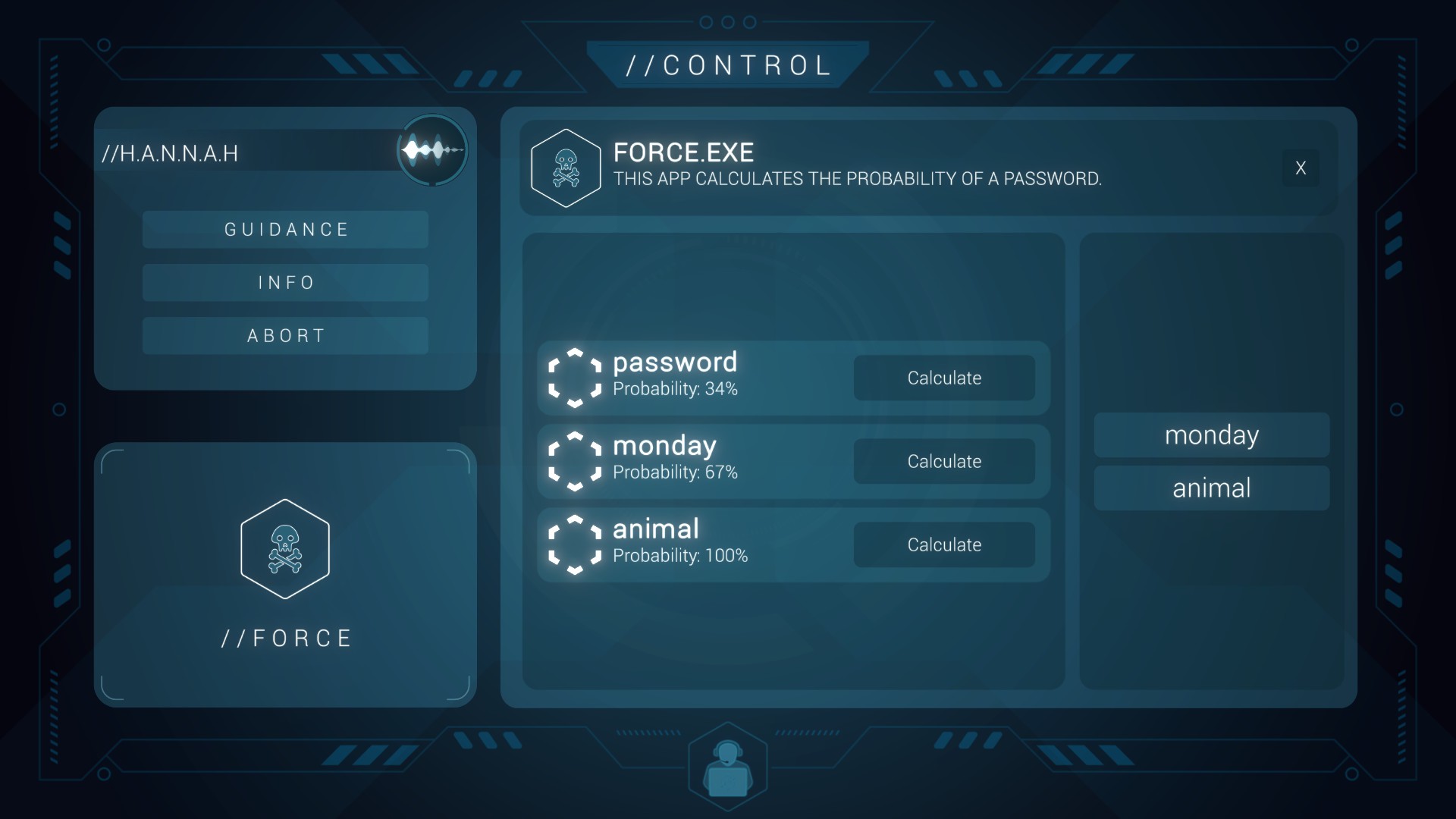
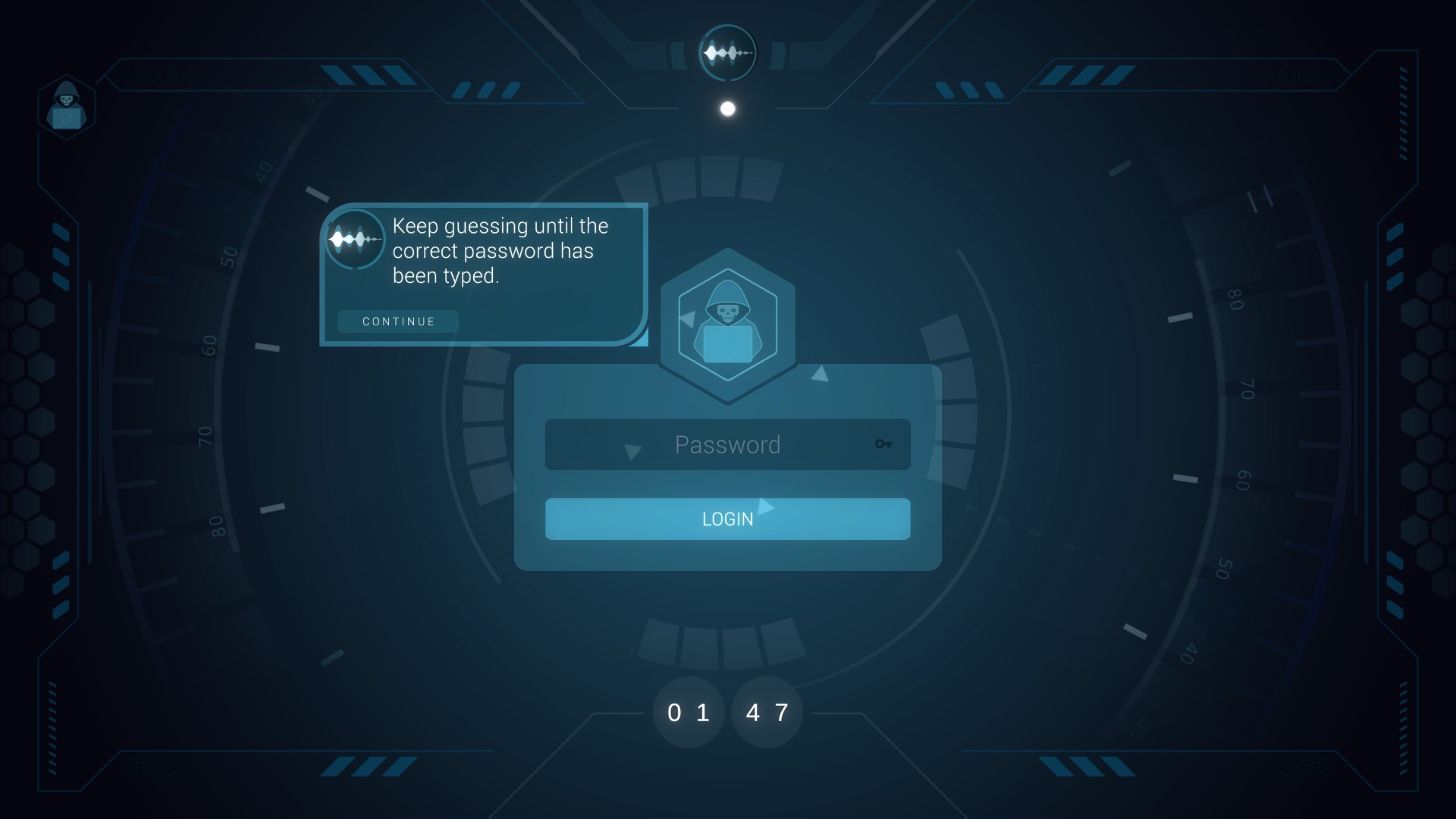
Force simulates guessing a password, however I’m not sure why, because the passwords are always dictionary words ripe for a dictionary attack that a script could easily brute force in less than a second. Sadly, the password is also never just “password” and never have any kind of number. Instead, gameplay involves The Hacker typing something random (and preferably short, as it will be wrong) in, giving The Controller the ability to click what they attempted, and being given possible passwords to try reading back to The Hacker to punch in. Eventually, you narrow the list down until you get a correct password.
It’s simple and straightforward and doesn’t have an interface screw to fail you arbitrarily like the other games, but it’s also utterly brain-dead trial-and-error that just feels like a waste of your time. Compare this to Fallout 3’s password-guessing minigame, for example. In that, you are also given words you can try as passwords, but you have a limited number of attempts, and they tell you how many characters were correct so that you actually have some method of getting closer to the correct password without the game just arbitrarily cutting the list down for you, leaving you something to actually mentally engage with. That system actually felt like a puzzle and if it wasn’t fun on its own, at least was engaging enough not to be boring. Simply being given a list of passwords to try until one is correct is boring.
Second up is Injection, or Injector. I keep getting them mixed up, and it’s a major pain because misspelling on the command prompts forces you to punch it back in. This is the one that steals the hacking minigame from BioShock, and makes you play the pipe connector game.
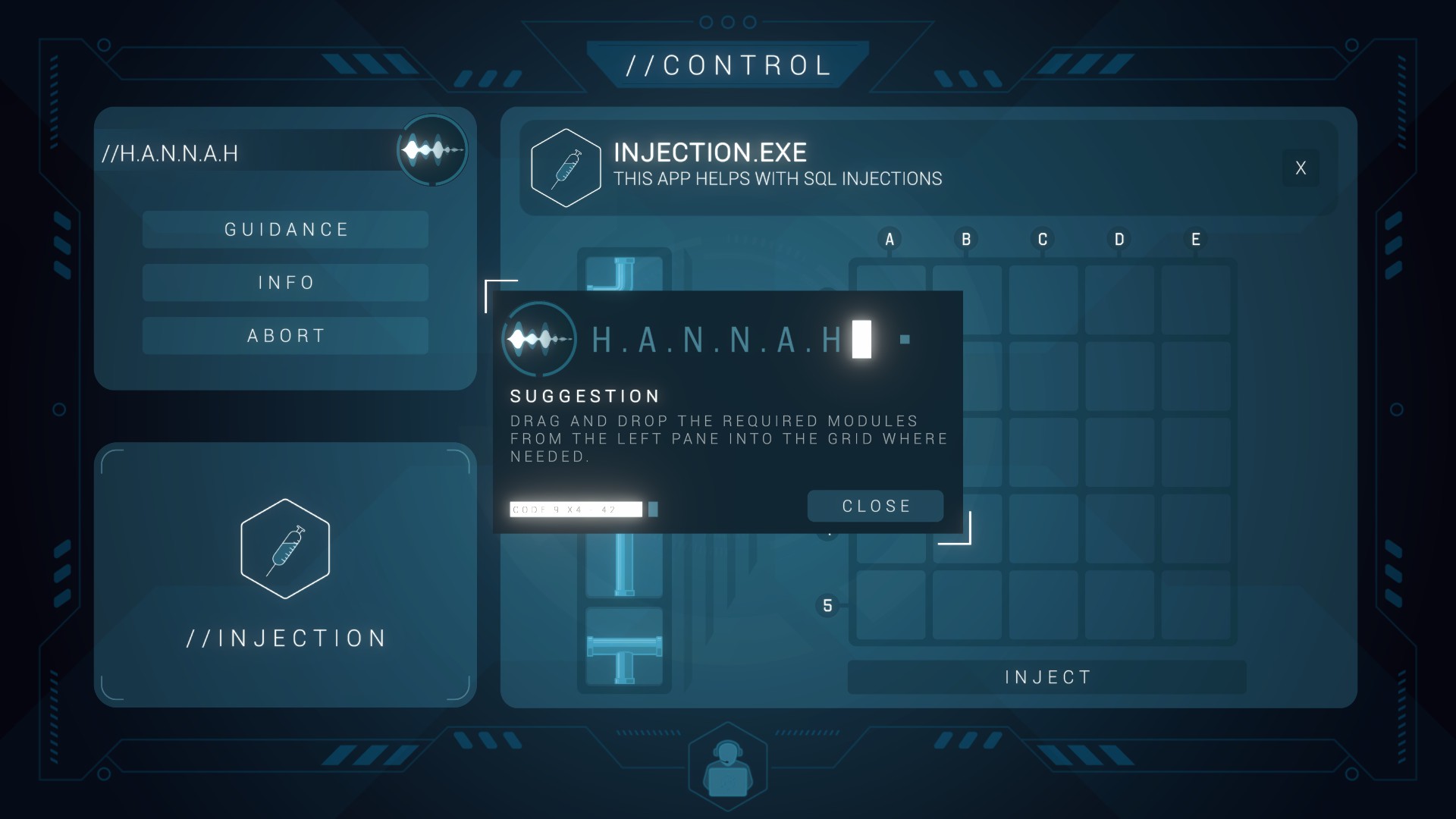
This was the first game I ran into major issues with the utter failure of a manual and the way that the interface is designed to be flagrantly counter-intuitive. The Control side is a blank grid where you can drag-and-drop pipes. The “guidance” says to drag-and-drop pipes “where needed” and to “follow instructions” from The Hacker. The problem is, again, it’s totally counter-intuitive what you’re supposed to do in this game, and The Hacker has no guidance of their own. Playing this single-player, and having the only instruction I’m given be to follow instructions from myself is just plain bewildering. How am I supposed to do this game, start sockpuppet theater?
Me: “Hey Me?”
Me: “Yeah, Me?”
Me: “The instructions say you’re supposed to tell me how we play this game, me.”
Me: “How the hell am I supposed to know that, Me?”
Me: “I dunno, are there any instructions over there?”
Me: “Heck no, there’s no interface at all – not even an ‘x’ button to go back a screen over here. I have no idea what interface features I can mess with, Me.”
Me: “Then why do the instructions tell me to ask you, Me?”
Me: “Because they’re horribly written, Me.”
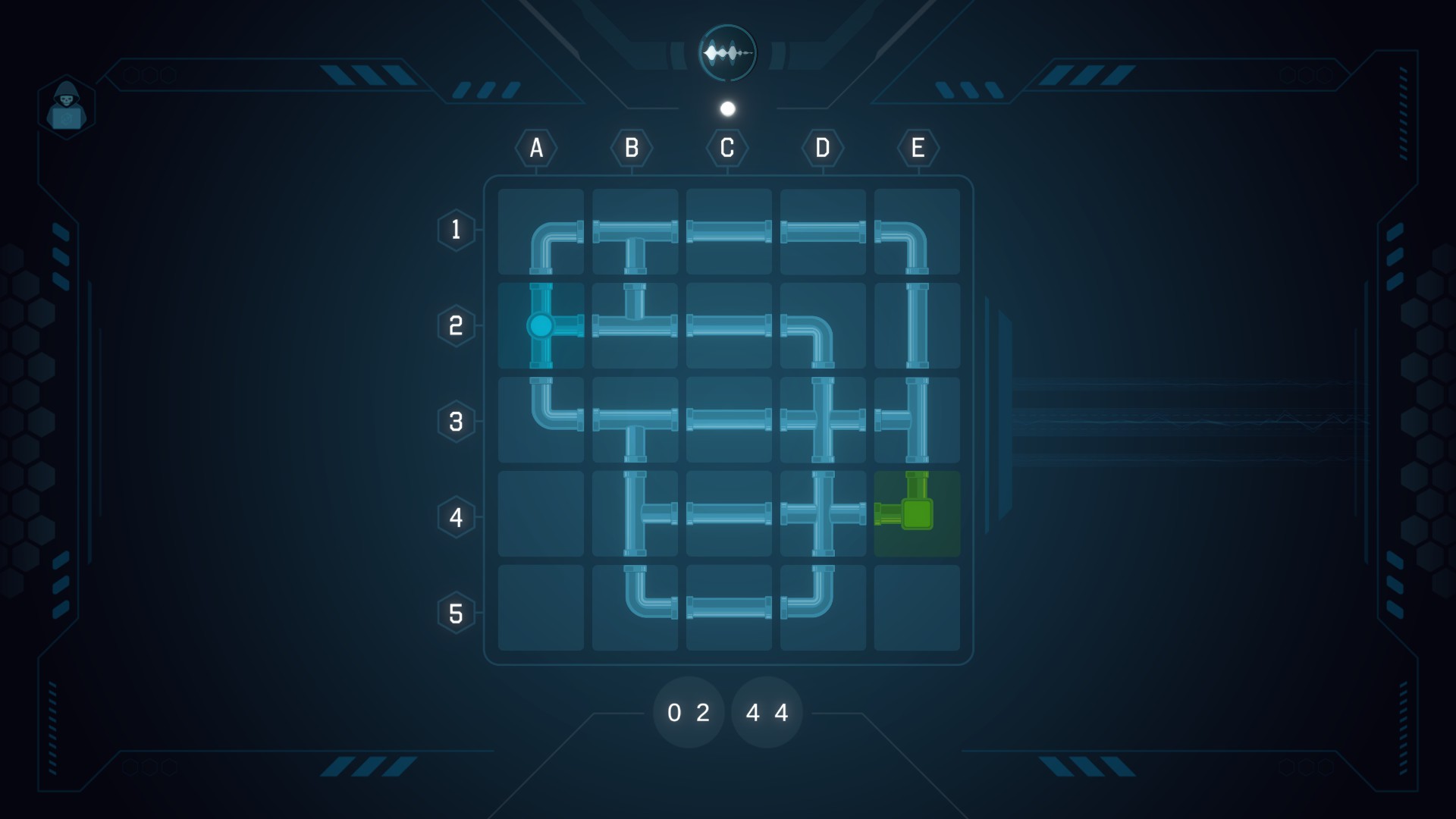
On The Hacker side, you’re given a littered mess of random pipe parts. Two are colored. OK, I’ve played games like this before, I need to connect the very-slightly-different blue piece to the green piece, right? (Seriously, why can’t you pick a color that stands out a little more? You have literally the whole rest of the spectrum to work with.) OK, I’ll have The Controller drop the pieces I need, and since several of the pieces that are already there are cross-pieces that would be a pain to avoid leaks with, I’ll just go around those. There, I made a no-leaks connection between slightly-more-blue and green. Now, hit “Inject” and– WRONG! FAILED! START THE MISSION OVER! Wait, what? How is this wrong, I obviously made a correct connection between the slightly-more-blue and green pieces. Let me do it again, just to make sure… WRONG! FAILED! START THE MISSION OVER! What the hell, game?! What am I supposed to do with these pieces if not connect the obviously differently-colored ones?
Wait… it can’t want me to… oh, look, it wants me to connect all the pieces without leaks. So then… why the hell are two pieces different colors if they aren’t different from any other pieces in any way?! This is exactly the kind of pitfall that the instructions fail to actually tell you about and deliberate counter-intuitive interface decisions that make me positively loathe this game. Any college interface designer would beat the developer with the interface textbook for this kind of ass-backwards design that deliberately leads the players to the wrong conclusion, while including instructions that presume that the players either already know how to play or can use psychic powers to infer what the developer intended with the wildly unintuitive game design, either one of which would obviate the need for instructions.
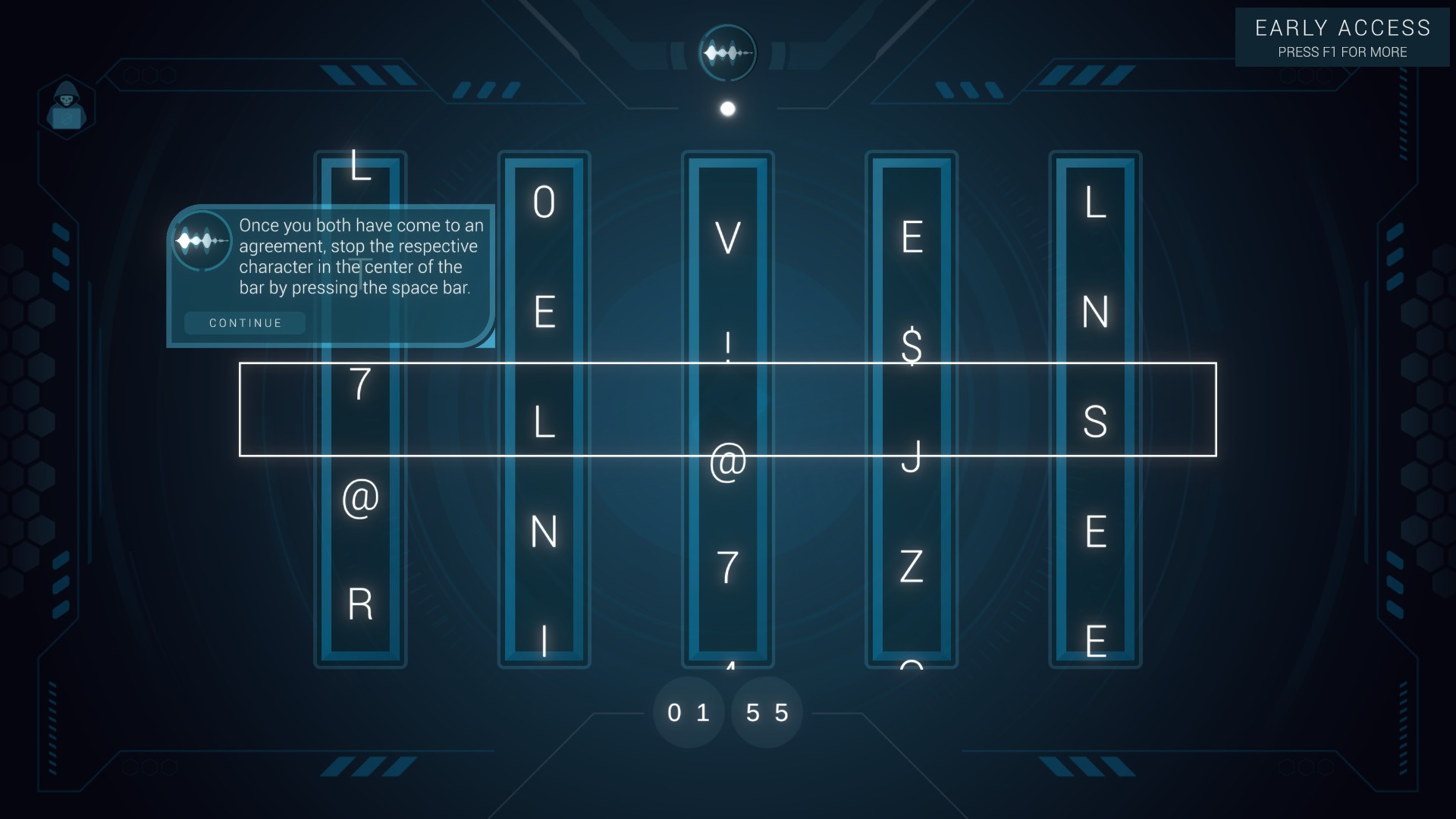
The Keylogger game involves characters spinning on a roulette that The Hacker stops by pressing space. (Not clicking like nearly everything else The Hacker does, because why have a consistent interface?) The Hacker needs to stop the wheel on specific letters, while The Controller is given a screen with characters that, after they press a “log” button, turn blue. (Why have to press a button when there’s no reason this couldn’t be automatic?) This indicates what characters could be the right one for The Hacker to stop the wheel on without failing. The Hacker reads out the possible correct answers, and if The Hacker sees one of those, stops is on them, or as the instructions bewilderingly state it “both come to an agreement”, as if this is a negotiation between players, not just player A telling player B “stop it on either a D, Z, Q, 4 or 3”.
So, what’s the secret interface screw thrown into this just to ruin players’ days? The Controller’s list isn’t complete. You have to click and drag on their wheel of letters to “turn” it to see other possible characters, even though there is absolutely no indication in the interface or the instructions that you can even do this, and there’s no reason the player would even try click-dragging random pieces of screen!
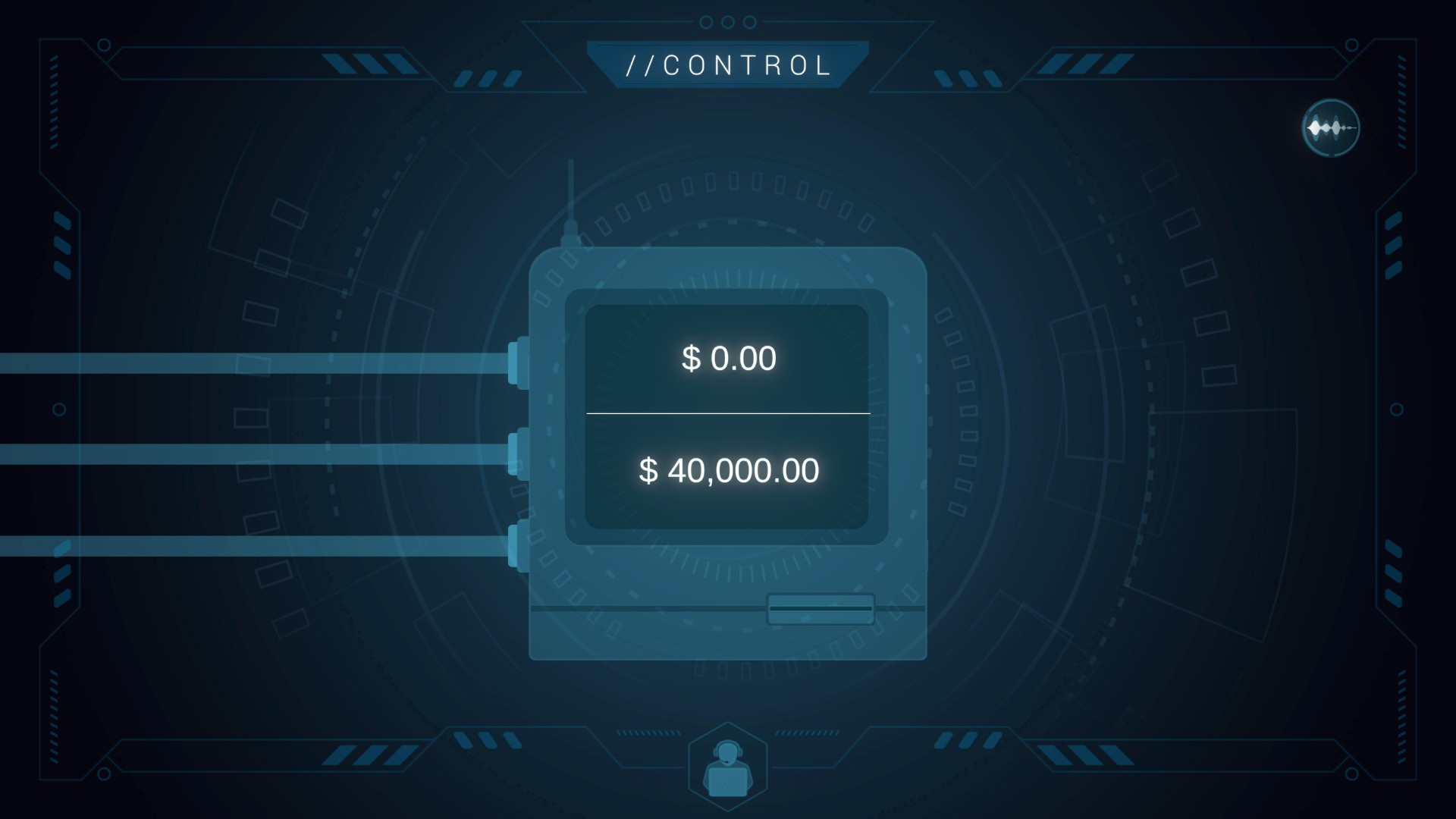
If you do get through all the nodes, you go on to a final “start transfer” portion of the mission. This is the one with the pipes going “shunk” into a safe. I’d like to point out that you can only get to this point after completing other time-consuming mini-games in missions that give you a time limit of four minutes. You are given no instruction on how to do this, and unlike every other Control minigame, there is no list of buttons for instructions… so… I just punch “start transfer” on The Hacker side, and wait for it to finish, right? … I’m just sitting here watching 1s and 0s move through the pipes. (Seriously, who thinks hacking is like this? And why does it take so long, you don’t individually transfer dollars digitally, it’s a lump-sum transfer.) OK, nothing seems to be happening on The Hacker side, so let’s look on The Controller side. Hey, the pipes are glowing red over here, I wonder why? Oh, look, I failed the mission again.
See, you’re now supposed to click the normally unclickable wave circle to be given instructions that you can only read after completing other nodes with a time limit still running to find out that The Conroller is supposed to watch out for money transfers being traced (making pipes glow red), and tell The Hacker which pipes to shut off by turning squeaking rusty valves on their screen. You basically just sit there and turn off the top valve. Now open it. Now the bottom two valves. Now open them. Now the top valve again. Now open it. [Sigh]. OK, we fail the mission if we go over, too, apparently, so shut the whole thing down. Now we get declared winrars. Yay. How exciting siting around playing effectively Red Light Green Light while watching a number get bigger.
Your reward for this is to have Angry Guy insult you and tell you to do another mission with different minigames in it.
I cannot stress enough that the only way to read the instructions for this, however, is to complete most of a mission, then open up the instructions and read them while the timer for the mission (which is only 4 minutes to start with) is still counting down. Because the instructions are also so badly-written and vague, it’s going to take that long to try to figure out what they hell they mean. This means that you need to fail the mission by reading the instructions for each node, complete those nodes to get to the transfer node, fail the mission again by reading the instructions to know how you’re supposed to play the game, then retry again before you can even have a chance of completing the mission. And that’s not counting the times you’re forced to restart because the instructions omit critical information or outright lie to you. Needless to say, even if the games were enjoyable, the sheer amount of bad will the tutorial (or lack thereof) engenders is so great I would have been having less fun playing them just from resentment over how the game actively worked against me enjoying them.
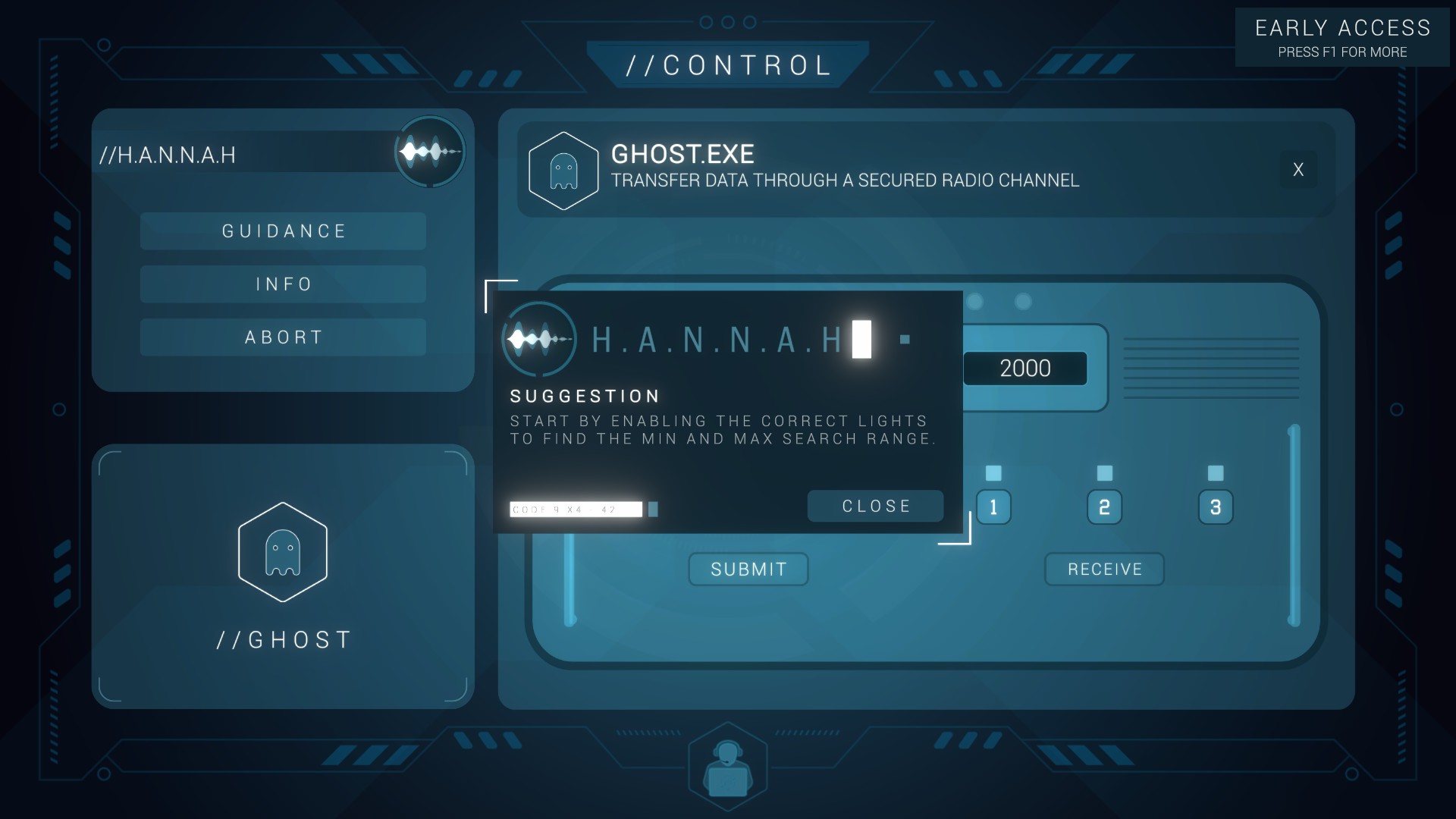
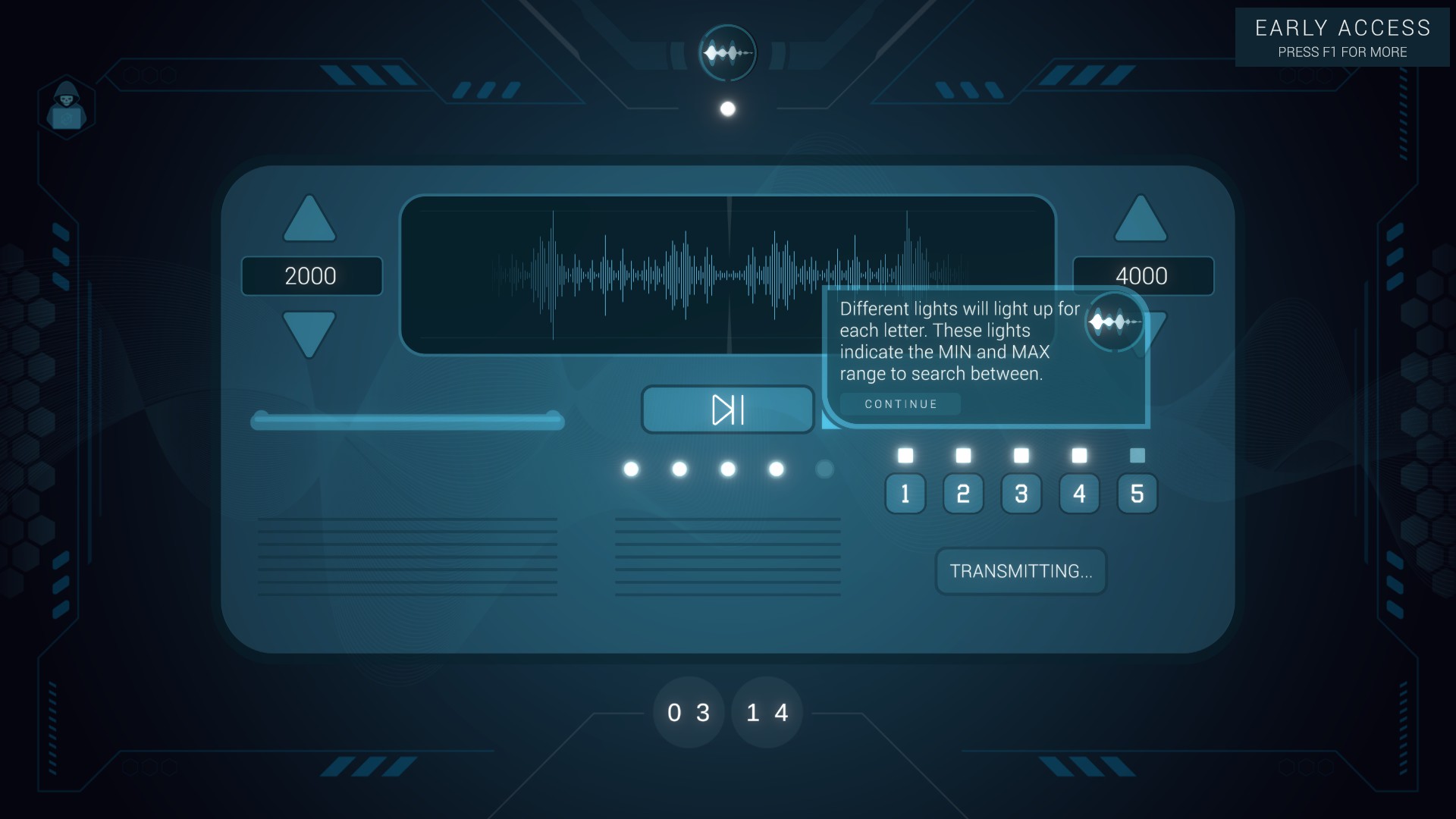
The Ghost game was the one where I decided that I didn’t have the patience to put up with trying to figure out how you’re supposed to play the game, anymore. You’re apparently supposed to sit and listen for someone to speak letters over the radio, but first you have to click certain lights to make signal come in. The problem is, I clicked everything that looked like buttons to make lights come on, and nothing worked. I figured that since this was the fourth time I’d ragequit the game because of a bad interface, and I’d seen no puzzles that were actually any fun to play, I’d basically seen enough to make my review.
Even if the game didn’t have a horrible interface or instructions and I could jump into playing it, the games aren’t any fun, they’re just tedious. There’s no sense that you’re solving a puzzle, just that you’re jumping through hoops. It’s literally a game of Red Light Green Light, which is a game associated with very young children for the same reason Candyland is a game associated with young children, and with none of the exercise benefits, while stressing over what may be a timer ticking down to near zero. All the frustration, none of the sense of achievement.
Affordances
The (or at least, one of) fundamental problem(s) of HEX is the concept of affordances, and the complete mishandling of them in this game. (Plus, there’s the whole “the mini-games are mindless, tedious busywork, not fun” aspect.) Affordances are the way that you present an object or in the case of a game, design the world or its interface to make the proper use of the interface or gameplay intuitive. This is as simple as the way that door handles are designed – you can make both sides of a shop door have a vertical bar handle, but that kind of bar makes you think you’re supposed to pull when, depending on which side of the door you are on, you need to either push or pull. If, however, you see a horizontal bar you push in, you instantly know that’s the push side of the door.
For examples in games, Valve popularized the practice of making it so that, if you’re in a large room which might take a while to explore, the room will be mostly dark, and the exit brightly lit or otherwise highly contrasting, because that naturally draws the player’s attention to that location, allowing them to quickly find an exit in an otherwise chaotic action game. Naughty Dog notably made all the climbable paths in Uncharted bright yellow while everything else in the environment (besides explosions and sky) tended to be dark gray so that the climbable path stands out intuitively.
Affordances are the unspoken language by which a developer communicates intent to the player, and in HEX, the affordances lie to the player. The things that look like buttons are not buttons, and the things that are buttons do not look like buttons. It adds a massive unnecessary level of frustration to have it fail so thoroughly at such a basic concept of game design.
Verdict
Even if the game competently gave instructions to reduce the frustration of playing it the first half dozen times, there wouldn’t be anything enjoyable in playing this game. If I wanted to be offered the promise of money for being yelled at for not exactly adhering to badly-explained or completely missing directions in a timed high-stress environment, I’d just go back to work. That’s what this game is: Work you don’t actually get paid for.











